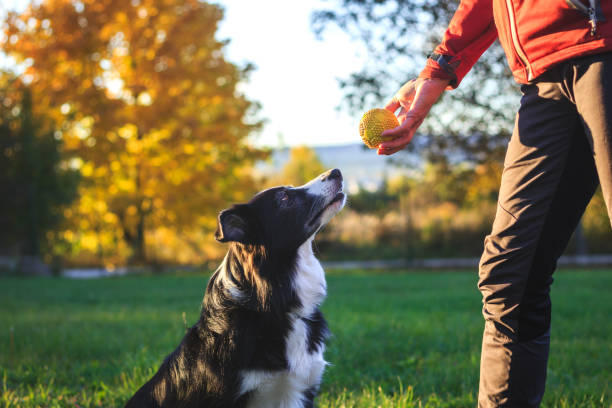The Power of Classical Conditioning: Transforming Dog Training with Positive Associations
The article explores the role of classical conditioning in dog training, highlighting its importance in shaping behavior, improving obedience, and fostering a strong bond between dogs and their owners.
Introduction to Classical Conditioning in Dog Training
Classical conditioning, a cornerstone of psychology, holds significant importance in dog training. This method entails linking neutral stimuli with meaningful cues to trigger specific responses in dogs. For instance, by associating the sound of a clicker with receiving a treat, a dog can learn to perform desired behaviors upon hearing the click. This technique forms the basis of classical conditioning in dog training, emphasizing the power of creating positive associations to influence behavior.
In the realm of dog training, classical conditioning enables trainers to establish a strong foundation for learning and obedience. By pairing a neutral stimulus, such as a whistle, with a rewarding experience like playtime, dogs can quickly learn to respond to the whistle with enthusiasm and eagerness. This process not only shapes behavior but also enhances the quality of the bond between dogs and their owners, fostering mutual understanding and trust. Understanding the principles of classical conditioning is paramount for dog owners seeking to enhance their training techniques and build a harmonious relationship with their canine companions.
Exploring the Extensive Impact of Classical Conditioning in Dog Training
Classical conditioning is a multifaceted concept that significantly influences a dog’s behavior beyond the boundaries of formal training sessions. It permeates every aspect of a dog’s daily life, shaping their interactions and responses to various stimuli [3]. For instance, the process of classical conditioning can be observed when a dog learns to associate the sound of a doorbell with the arrival of guests, eliciting excitement or alertness. These learned associations are fundamental in molding a dog’s behavior and emotional responses in different situations.
Furthermore, the effectiveness of classical conditioning in dog training lies in its ability to foster positive associations. By pairing a neutral stimulus with a rewarding or pleasurable experience, dogs can quickly learn and exhibit desired behaviors. For example, a dog may be conditioned to associate the sound of a clicker with a treat, prompting them to perform a specific action upon hearing the click. This method not only enhances obedience but also strengthens the bond between the dog and their owner through shared positive experiences. Preventative classical conditioning is equally crucial in preparing dogs to navigate the world confidently, as it helps them avoid developing phobias or anxieties that could hinder their emotional well-being.
In conclusion, the pervasive nature of classical conditioning in dog training underscores its significance in shaping a dog’s behavior, emotional responses, and overall quality of life. By leveraging the principles of classical conditioning effectively, dog owners can create a harmonious environment that nurtures positive learning experiences and strengthens the connection between them and their furry companions. Explore the profound impact of classical conditioning in dog training further by delving into innovative techniques at Off Leash K9 Training’s website.
 Applying Classical Conditioning Techniques Effectively
Applying Classical Conditioning Techniques Effectively
When applying classical conditioning techniques in dog training, it is crucial to understand how they can effectively alter emotional responses and behaviors in our canine companions. By creating positive associations with particular stimuli, such as treats or toys, dogs can learn to associate these stimuli with positive experiences, leading to desired behaviors and responses. For instance, using classical conditioning, a dog that used to fear car rides can be gradually desensitized and positively reinforced during short, pleasant car trips, ultimately changing its emotional response from fear to enjoyment.
Moreover, the incorporation of classical conditioning principles in dog training programs can yield a myriad of benefits for both dogs and their owners. Not only can this approach result in a reduction of aggressive behaviors and improved socialization skills, but it can also enhance the overall obedience and responsiveness of dogs in various situations. For example, a dog exhibiting signs of aggression towards other dogs can be systematically exposed to positive interactions through classical conditioning, leading to a shift in behavior from aggression to friendliness. This transformation showcases the power of classical conditioning in shaping a dog’s responses based on the associations they form with their environment.
Therefore, dog owners are encouraged to consider the profound impact that classical conditioning can have on their pets’ behavior and well-being. By recognizing the role of classical conditioning techniques in fostering positive associations and desired behaviors, owners can nurture a strong and harmonious relationship with their furry companions while achieving remarkable training outcomes. Explore the possibilities of classical conditioning in dog training to unlock your dog’s full potential and strengthen your bond with them. Visit Off Leash K9 Training’s website at Off Leash K9 Training for more insights and personalized training solutions.
Contrasting Classical Conditioning and Operant Conditioning
Classical conditioning, a fundamental concept in dog training methods, stands apart from operant conditioning with its primary focus on the formation of associations between stimuli and responses. For instance, when a dog learns to associate the sound of a clicker with receiving a treat, classical conditioning is at play as the dog starts to salivate in anticipation of the reward. This type of conditioning is crucial in shaping a dog’s automatic reflexes and involuntary reactions to various stimuli in its environment, leading to desired behaviors without the need for direct commands or cues.
On the other hand, operant conditioning in dog training is centered around modifying behaviors through a system of reinforcement and punishment. For instance, when a dog is taught to sit on command and receives a treat for complying, operant conditioning is at work as the behavior is strengthened through positive reinforcement. Unlike classical conditioning, which focuses on the emotional responses and associations, operant conditioning targets voluntary behaviors where dogs actively engage in actions to receive rewards or avoid consequences. By understanding the distinctions between these two conditioning methods, dog trainers can tailor their approaches to address specific training goals and challenges effectively, ensuring a well-rounded training experience for both dogs and their owners.
 Benefits of Marker Training in Dog Training Programs
Benefits of Marker Training in Dog Training Programs
Marker training, a form of positive reinforcement, is a valuable technique in dog training that involves using markers such as clickers to signal desired behaviors in dogs. This approach enhances communication between trainers and dogs, providing clear feedback and reinforcement for correct behaviors. By incorporating marker training into dog training programs, trainers can accelerate learning, improve focus, and strengthen the bond between dogs and their owners.
Furthermore, marker training is particularly effective in shaping complex behaviors by breaking them down into smaller, more manageable steps. For instance, in teaching a dog to perform a new trick like rolling over, the trainer can use the clicker to mark each incremental progress, such as lying down, turning the head, and finally completing the full roll. This method not only helps the dog understand the desired behavior more easily but also boosts their confidence as they achieve success step by step.
Moreover, marker training is highly versatile and can be applied to various training scenarios, from basic obedience commands to advanced agility routines. For example, in agility training, the clicker can be used to mark specific movements or obstacles successfully navigated by the dog, reinforcing positive behaviors and encouraging the dog to repeat those actions in future training sessions. This precise feedback mechanism allows for efficient communication between the trainer and the dog, leading to quicker learning outcomes and a more enjoyable training experience overall.
 Off Leash K9 Training’s Innovative Approach to Marker Training
Off Leash K9 Training’s Innovative Approach to Marker Training
At Off Leash K9 Training, marker training is not just a technique but a fundamental philosophy that underpins their dog training programs. They go beyond teaching commands to fostering a deep understanding of classical conditioning principles in dogs of all breeds and ages. For instance, by associating the sound of a clicker with a treat, dogs quickly learn to connect the positive reinforcement with their actions, leading to faster and more effective learning. This approach ensures that dogs are not just obeying commands but are actively engaged and motivated throughout the training process, resulting in long-term behavioral changes.
The success of Off Leash K9 Training’s marker training lies in the trainers’ expertise in leveraging classical conditioning to create lasting positive experiences for dogs. For example, by using markers like clickers consistently during training sessions, dogs learn to anticipate rewards, which boosts their confidence and eagerness to learn. This method not only enhances communication between trainers and dogs but also strengthens the bond between dogs and their owners, making training sessions more enjoyable and rewarding for both parties. To experience the transformative power of marker training and classical conditioning principles, visit Off Leash K9 Training’s website at https://www.offleashk9training.com/ and discover how their innovative approach can benefit your furry companion.
Conclusion on the Role of Classical Conditioning in Dog Training
Classical conditioning plays a vital role in shaping a dog’s behavior, extending beyond formal training sessions to impact daily interactions and responses. Dogs can be effectively trained using classical conditioning to establish positive associations with various stimuli, leading to improved behavior and enhanced obedience. For instance, classical conditioning can help a dog associate the sound of a clicker with receiving a treat, reinforcing desired behaviors.
Moreover, preventative classical conditioning can significantly benefit dogs by helping them avoid developing fears and anxieties, contributing to their overall well-being and confidence. By creating positive associations through classical conditioning techniques, such as pairing unfamiliar noises with treats during socialization, dogs can become more adaptable and less fearful in various situations. This approach not only fosters a positive environment for the dog but also strengthens the bond between the dog and its owner.
To explore the transformative effects of classical conditioning in dog training further, consider the marker training programs offered by Off Leash K9 Training. Their personalized and innovative training solutions leverage classical conditioning principles to create positive associations, boost confidence, and enhance the overall training experience for both dogs and their owners. Visit the Off Leash K9 Training website at https://www.offleashk9training.com/ to discover how classical conditioning can revolutionize your dog’s training journey.







